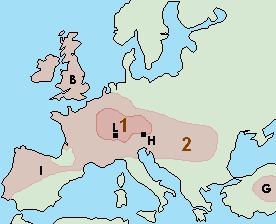 | ||
The Continental Celtic languages are the Celtic languages, now extinct, that were spoken on the continent of Europe, as distinguished from the Insular Celtic languages of the British Isles and Brittany. Continental Celtic is a geographic, not a linguistic, grouping of the ancient Celtic languages. The Continental Celtic languages were spoken by the people known to Roman and Greek writers as Keltoi, Celtae, Galli and Galatae. These languages were spoken in an arc stretching across from Iberia in the west to the Balkans and Anatolia in the east.
Contents
Even though Breton is spoken in continental Europe, and has been since at least the 6th century AD, it is not considered one of the Continental Celtic languages. It is a Brittonic language closely related to Cornish and Welsh. Whilst it has been suggested that there is a Gaulish substratum in the Vannetais dialect (Galliou and Jones 1991) the historical and linguistic evidence shows otherwise.
Attested Continental Celtic languages
Although it is likely that Celts spoke dozens of different languages and dialects across Europe in pre-Roman times, only a small number have been attested:
Use of term
The modern term Continental Celtic is used in contrast to Insular Celtic. While many researchers agree that Insular Celtic is a distinct branch of Celtic (Cowgill 1975; McCone 1991, 1992; Schrijver 1995), having undergone common linguistic innovations, there is no evidence that the Continental Celtic languages can be similarly grouped. Instead, the group called Continental Celtic is polyphyletic and the term refers simply to non-Insular Celtic languages. Since little material has been preserved in any of the Continental Celtic languages, historical linguistic analysis based on the comparative method is difficult to perform. However, other researchers see the Brittonic languages and Gaulish as forming part of a sub-group of the Celtic languages known as P-Celtic. Continental languages are all P-Celtic except for Celtiberian, which is Q-Celtic, and have had a definite influence on all the Romance languages.
